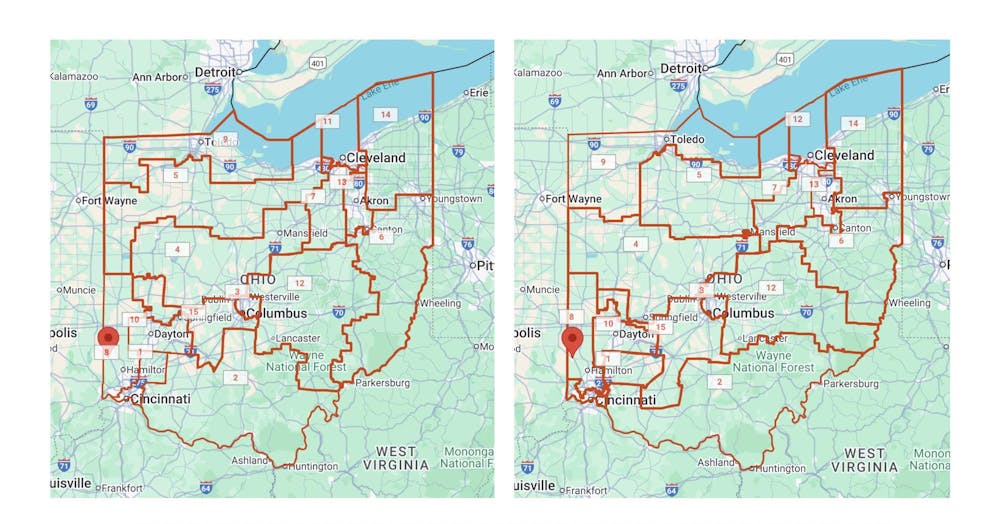“If you don't play the game, you lose.”
On Halloween, Ohio lawmakers on the state’s redistricting commission approved new congressional maps that will favor Republican seats in upcoming elections, including the midterms next year.
The redistricting committee consists of the governor, state auditor, secretary of state, an individual appointed by the senate president, an individual appointed by the speaker of the Ohio House, an individual appointed by the senate minority leader and an individual appointed by the Ohio House minority leader. Five out of the seven members of the committee are Republican; however, the maps passed with bipartisan support from all seven members.
Drew Belcher, chairman of the Miami University College Republicans, said that while he believes these maps favor Republicans, the issue of gerrymandering is abused by both political parties.
“If Republicans don't do it, Democrats are gonna do it,” Belcher said. “So it's either you do exactly what [the Democrats] are doing, or [Republicans] are going to hold the moral high ground on this, and we're going to lose. From a political standpoint, you don't get anything done that way.”
Republicans currently hold 10 of the 15 congressional seats in Ohio; however, with the newly-approved maps, Republicans have the potential to slide into two more of those seats: Rep. Greg Landsman, Democrat of Ohio’s 1st District, and Rep. Marcy Kaptur, Democrat of Ohio’s 9th District. The maps were required to be redrawn by the Ohio Constitution, which states that if the original maps, drawn once a decade in 2021, do not have bipartisan support, then they need to be redrawn after five years.
Enjoy what you're reading?
Signup for our newsletter

The current U.S. Congressional map (left) compared to the newly-approved U.S. Congressional map (right). The new maps target districts near Toledo, Akron and Cincinnati.
Outside of Ohio, 12 states have either discussed, enacted or are pending approval for new congressional maps, according to a tracker by CNN Politics. However, out of the 13 total states redrawing their maps, only Ohio is constitutionally obligated to do so.
“Nobody should be doing this except Ohio,” said Elisabeth Warner, communications director for the League of Women Voters of Ohio (LWVO). “Everybody else who's doing it is doing it to gerrymander their state.”
Last fall, the Fair Districts Ohio coalition, which is led by LWVO and Common Cause Ohio, played a leading role in the Citizens Not Politicians campaign – or Issue 1. The campaign proposed an amendment to the Ohio Constitution that would take the power to draw congressional maps out of the hands of politicians and lobbyists and into a 15-person, non-partisan committee. The committee would be composed of five Democrats, five Republicans and five independent voters. Warner said the issue failed due to distorted ballot language, manipulative advertising and bad-faith rhetoric.
“It failed because voters were lied to and because the people who have the power cheated,” Warner said. “What the politicians did was they basically tricked voters into thinking that our amendment was going to create gerrymandering, and they used the political levers of power that they had.”
Since then, conversations throughout Ohio and on Miami’s campus regarding gerrymandering have increased with the current efforts to redraw maps nationwide.
Monica Schneider, professor of political science, said she discusses gerrymandering with her students in American Political System (POL 241), an introductory political science class offered both to majors and those completing the Miami Plan.
“Gerrymandering is arguably one of the most important factors in determining elections in American politics,” Schneider said. “So, it's obvious that you have to teach it to students.”
Schneider said she presents the topic of gerrymandering through current events, both in Ohio and in other states around the country, like Texas and California. Like Belcher, she said she talks about it as an issue taken up by both political parties, not just by the Republicans in Ohio.
“It's easy to feel like you're picking on Republicans for doing gerrymandering in Ohio, but I try to always point out that if the Democrats were in charge, they would probably be doing the same thing,” she said.
One of her students, first-year Reagan Williams, said as an Ohio resident, he appreciates the discussion of gerrymandering as it relates to what’s going on in the news. A chemical engineering major, Williams took this class as an opportunity to explore his interest in politics.
“[Our discussions] mostly involve examples and explaining the process,” Williams said. “[Redistricting] is related to the process of electing officials more broadly, and how political power can be manipulated one way or the other.”

Ohio Secretary of State Frank LaRose published the updated map online following the Oct. 31 approval, which will be in affect until 2032.
Ohio has turned increasingly red in recent years, voting Republican in the last three presidential elections. With these newly-redrawn maps, targeting districts near Toledo, Akron and Cincinnati, Republicans have the potential to take two more seats in the midterm elections next year; however, these seats are still very much up for grabs.
“There are five Republican representatives – that may change, that may not change,” Warner said. “The point is, this map was drawn behind closed doors. It's a product of a deal made by politicians that the public did not have the opportunity to weigh in on, and that's the part that is fundamentally anti-democratic.”




